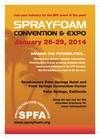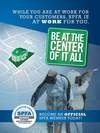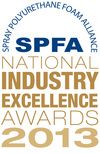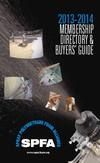SPFA Presents at the Center for the Polyurethanes Industry Annual Conference
SPFA staff including Kurt Riesenberg, Executive Director, Kelly Marcavage, Certification Director, and Dr. Richard Duncan, Technical Director, along with Bonnie Strickler, President of PUFF Inc, all presented at the CPI Annual Conference on various topics. The new SPFA PCP certification program was highlighted along with movement of the program to accommodate company accreditations and international delivery, and SPFA exhibited in the tabletop display area. Attendance was up again for several straight years. Congratulations to CPI for another great event.
SPFA Commits Resources on Sprayfoam to Homebuilders
The SPFA Board announced a commitment to complete a builder’s checklist on SPF to improve SPF contractor – builder communication. The checklist, expected to be surpassed over time with more materials oriented toward the builders and customers, will offer useful information on installation quality, health and safety, typical planning considerations for a worksite, and highlight information about SPFA’s Professional Certification Program (PCP) to inform and empower builders on the topics that are most relevant to them.
"One of the most important things we can do as an industry to maintain a high level of quality, safety and OSHA compliance on the worksite is to coordinate with those other stakeholder industries that typically share the worksite with us," said Kurt Riesenberg, Executive Director of SPFA. "The relationship and communication between builder and sprayfoam contractor in the field is essential for success, and that is reflected in SPFA working with the National Association of Homebuilders (NAHB) to facilitate similar conversations across our industries," he continued.
Board Updates
At the SPFA Board of Directors meeting at SPFA headquarters in Fairfax, Va., members made motions to support the following actions of staff:
1.Formation of an inter-industry Advisory Council to the PCP certification program allowing for partner industry organizations to coordinate on delivery, topical coverage and promotion.
2.Formation of a short-term task group to work with several builders identified by NAHB in completion of SPF-specific resources and materials for homebuilders.
3.Development of materials and efforts, and specific coordination for informing and assisting member contractors on issues related to the newly-released OSHA NEP.
Hybrid Insulation Guide
SPFA’s Building Envelope Committee (BEC) is finalizing the hybrid insulation guide, developing a model insulation specification (CSI Format), and insulation installation certificate to include fire protection coatings, for SPFA member contractors to use. These new documents will help member contractors to gain new business by improved product-type selection and avoid compliance issues with building code officials.
SPFA Forms Advisory Council/Safety Committee for New PCP Certification Program
SPFA recently held its Board of Directors meeting and produced several actions, including the agreement over a formation of an Advisory Council for the new PCP certification program consisting of representatives from general construction and industry. The Board also directed staff to form a Task Group with NAHB representatives to complete a reference document on SPF for homebuilders, and committed to bringing more accessible resources to its members similar to the recent webinars on ventilation practice, building science and the new OSHA NEP.
The Safety Committee will supporting the SPFA PCP certification program, and within its scope of work consider producing things like monthly or bi-monthly webinars on chemical and jobsite safety topics, possible development of model written safety and respirator protection programs for SPFA member contractors. The new SC is working presently to develop a set of OSHA/ANSI compliant jobsite safety signs, with two slated for release later this year.

Start Planning for SprayFoam Convention & Expo, Jan. 26-29, 2014
-Network and develop valuable connections.Join your industry for the SPF event of the year! Imagine the possibilities:
-Find solutions to your pressing business needs.
-Learn about advances in the SPF industry.
-Get the training you need to be the best.
Industry-Level Environmental Product Declaration (EPD) for SPF in Progress
In November 2012, SPFA released final reports that documented the SPF industry's Life Cycle Assessment (LCA) study. This announcement and detailed report can be found by clicking here. This study documents the detailed results of the overwhelmingly net-positive environmental impacts of generic LD, MD and roofing SPF products from cradle to end-of-life. The six impacts studied include primary energy demand, global warming (carbon footprint), ozone depletion, eutrophication (nitrogen release), smog and acidification (acid rain). While the study met all requirements of ISO-14040 and 14044, the results need to be summarized in a third-party environmental product declaration (EPD). EPD's, following the Product Category Rules (PRC) for insulation, provide an important verification of the results that assist in product selection under sustainable building programs such as USGBC's LEED, IgCC, GreenGlobes and other similar programs. UL Environments will be the most likely developer of the SFPA's industry-level EPD. For more information on the EPD development, please contact Rick Duncan, Technical Director of SPFA at rickduncan@sprayfoam.org.
|

Demilec Secures Growth Investment
Source: demilecusa.com
On Oct. 2, Demilec announced a definitive agreement to secure a significant growth investment from an affiliate of Sun Capital Partners, Inc., a private equity firm that invests in market-leading companies that are managing rapid growth. Sun’s professionals help drive performance by leveraging substantial in-house operational resources and expertise. Sun Capital affiliates have invested in more than 325 companies worldwide with combined sales in excess of $45 billion since 1995.
The financial commitment of the investment will allow Demilec to expand organically and also through mergers and acquisitions. Demilec’s owners – Jacques Lariviere, Dave Lall and Daniel Clayton – will remain as members of the senior leadership team and as significant shareholders in the business.
As part of the transaction, our Canadian and U.S. businesses (including PFSI, Cornell and Premilec) will be combined into a single operating entity. Also, the Demilec’s legal name has changed to Demilec USA, Inc.
Alliance, Sen. Shaheen Honor Jim Rogers with Lifetime Achievement Award
Source: ase.org
The Alliance to Save Energy and Sen. Jeanne Shaheen (D-N.H.) honored Duke Energy chairman and former chief executive Jim Rogers with the Lifetime Achievement Award at the annual Stars of Energy Efficiency awards dinner. The prestigious, black-tie event draws over 500 energy influencers from government, industry, and academia to showcase the year’s most impressive achievements in energy efficiency.
SFC Releases New SPF Inspection Guidance
Source: polyurethane.americanchemistry.com
A new Spray Foam Coalition guidance document, "Guidance on Sampling Techniques for the Inspection of Installed Spray Polyurethane Foam," was released recently. It is intended for inspectors who are familiar with spray polyurethane foam to provide general guidance and present techniques that can be used for the inspection and sampling of SPF insulation projects, with an emphasis on observation and physical sampling. Click here to see all recent SFC documents.
New 2012 Polyurethane End-Use Market Survey Now Available to Order
Source: americanchemistry.com
The Center for the Polyurethanes Industry (CPI) of the American Chemistry Council today announced that the 2012 End-Use Market Survey on the Polyurethanes Industry in the United States, Canada and Mexico is now available to order. The 2012 End-Use Market Survey is available in electronic copy only.
Survey Says? Federal Government Agencies Agree Energy Efficiency Is "Most Effective" Tool
Source: ase.org
Is energy efficiency still "top of mind" for federal agency decision-makers? To answer this question, the Alliance to Save Energy and Schneider Electric have collaborated to release their second survey of over 200 federal government executives with purchasing decision-making authority, a follow-up to the insightful 2010 inaugural survey, shedding light on how this key demographic views energy efficiency at their agencies.
Three-quarters of respondents agree that energy efficiency is still one of the most effective ways to meet our energy needs while reducing costs and lowering emissions. However, nearly 40 percent cite a lack of funding as the biggest obstacle, indicating the federal government needs to invest more in energy efficiency so agencies can cut waste, become more productive, and save taxpayers money – something long advocated for by the Alliance and Schneider Electric.
The survey also asked participants to identify attitudes toward energy efficiency within the agency and obstacles to compliance, as well as rank the importance of energy efficiency at their agencies and grade the agencies’ ability to comply with federal energy efficiency mandates.
CPI and BPI Offer Free Sprayfoam Training Continuing Education
The Center for the Polyurethanes Industry (CPI) and the Building Performance Institute, Inc., (BPI) added spray polyurethane foam (SPF) chemical health and safety training courses to BPI’s continuing education program. CPI’s training programs for High- and Low-pressure SPF Chemical Health and Safety are now eligible to contribute part of the requirements needed in earning a BPI credential. Each CPI course has been approved for 2-2.5 CEU by BPI.
ASHRAE/IES Publish First Standard Focused on Commissioning Process
Source: ashrae.org
A newly published standard focused on the commissioning process will help ensure a fully functional, fine-tuned facility. ANSI/ASHRAE/IES Standard 202, Commissioning Process for Buildings and Systems, identifies the minimum acceptable commissioning process for buildings and systems as described in ASHRAE’s Guideline 0-2005, The Commissioning Process. Standard 202 is ASHRAE’s first standard focused on the commissioning process. The commissioning process as detailed in Standard 202 applies to all construction projects and systems and is an industry consensus document. To purchase ($72), contact ASHRAE Customer Contact Center at 800-527-4723 or visit www.ashrae.org/bookstore.
New Index Shows Housing Markets Back to Normal in 52 Metros
Source: nahb.org
Housing markets in 52 out of the approximately 350 metro areas nationwide have now returned to or exceeded their pre-recessionary levels of activity, according to the newly minted National Association of Home Builders/First American Leading Markets Index (LMI), released Oct. 7. The index’s nationwide score of .85 indicates that, based on current permits, prices and employment data, the nationwide housing market is running at 85 percent of normal activity.
CPI Congratulates 2013 Best Paper and Poster Winners
Source: americanchemistry.com
The Center for the Polyurethanes Industry (CPI) of the American Chemistry Council congratulated the winners of the best paper and best poster awards from the 2013 Polyurethanes Technical Conference. "The 2013 conference featured 68 technical papers and 27 posters, and this year’s winners stood out among a crowd of extremely high-quality work," said CPI Senior Director Lee Salamone. "CPI offers our congratulations to this year’s winners and our thanks to everyone who participated in this year’s conference. With nearly 950 attendees, the 2013 conference was a great success."

As part of its ongoing efforts to promote the design and use of safer chemicals, today, the U.S. Environmental Protection Agency (EPA) has released a draft report on alternatives to a flame retardant chemical, hexabromocyclododecane (HBCD), which has persistent, bioaccumulative and toxic characteristics. The findings in the report can help manufacturers identify safer alternatives to the use of HBCD in polystyrene building insulation.
A coalition of construction industry groups is concerned about a proposed rule from the Occupational Safety and Health Administration (OSHA) that’s intended to protect workers from inhaling dust containing silica, created by activities such as cutting brick or block, and sawing, grinding or drilling concrete. Announced Aug. 23 in a press conference that laid out few details, the proposed rule seems to call for one-size-fits-all measures that contradict existing safety and quality assurance practices for different types of contractors.
|
Some of the articles in the SPRAYFOAM Professional Fall 2013 issue, which will be released shortly, include:
2013 SPFA CONTRACTOR AWARDS
>>RESIDENTIAL WALL FOAM -- Seven Days in the Desert with Southwest Spray Foam LLC
THRIVING, NOT JUST SURVIVING -- SPF Helps Turns Survival Condos Into Luxury Living Spaces
SPEAKING SENSIBLY -- Ventilation and Moisture Control in Sprayfoam/Tight Homes
SAFETY FIRST -- Isocyanate Enforcement Activities by OSHA
If you didn't receive this issue in the mail or via email and would like to be on future distribution lists, click here to sign up.
|

 SPFA Publishes New Membership Brochure SPFA Publishes New Membership BrochureAvailable on the SPFA website, the brochure highlights some of the various benefits of membership and activities of the organization as it pursues its mission to represent SPF professionals in areas of technical and environmental leadership, government advocacy, professional certification, industry promotion and outreach, and delivery of a world-class convention and expo. Please check out the brochure if you have been considering joining SPFA and support our mission to serve you.
For more information or to access the application to join, please click here.
SPFA Membership Directory and Buyers' Guide
Members in good standing are listed in this publication, which was mailed to members in September. This directory is also available in a digital format at www.naylornetwork.com/spfa. The convenient digital format allows users to navigate and access the directory's content quickly and easily, on the road or in the office. Use the information provided to contact fellow SPFA members and industry partners throughout the year to share ideas, ask questions, or just stay in touch.

SPFA 2013 National Contractor Excellence Award Winning ProjectsCongratulations to all the winners in the 2013 Annual SPFA National Contractor Excellence Awards. These projects are examples of SPF’s unique performance, applicability and appeal. In upcoming issues of SPRAYFOAM Professional, various winning projects will be spotlighted.
Here are the 2013 winners:
>>Arizona Foam & Spray: Temple of the Church of Jesus Christ of Latter-Day Saints
>>Spray-Tec Inc.: Bluegrass Community and Technical College Newtown Pike Campus
>>Southwest Spray Foam LLC: Television Personality Steve Thomas
>>Smart Choice Insulation & Roofing, Inc.: The Flour Tower
>>West Roofing Systems, Inc.: Boulevard Terrace & Neal Terrace Apartments
>>Honeywell Building Envelope Solutions: 206,000 sq.ft. re-roofing over BUR with extensive removal
>>Biofoam: Fermilab
>>West Roofing Systems, Inc.: Playhouse Square 14th Street Theatre Roof Reconstruction
>>Insulate SB, Inc: The Book House
>>J. Calman Industries: Coastal Progress – Marine Vessel
SPFA Member Benefits
SPFA knows there are lots of organizations out there that would like to have you in their membership. But if you are in, or getting into, the sprayfoam business, we are the place for you. We work hard to represent you well and give you value back for your support. Click here to find out more.
|

ICAA Annual Conference in Tucson Referred to as "Sprayfoam Lite" Fall Conference
Is ICAA suffering from an identity crisis? After years of ignoring and even eschewing SPF, and being managed by a board of fiberglass companies, the ICAA agenda and news suddenly are dominated by SPF. Where is ICAA in government advocacy on impactful SPF issues, on assisting members with daily difficult field, code and technical challenges, on investing in the costly efforts of proving performance through research, development and industry certification programs, and on a deep-bench of installation, chemical and building science expertise? The marathon of industry is not won by a quick sprint to catch up after the pack has passed you by. It’s won by consistent hammering out every day of solid and reliable effort. While ICAA may be a temporary target-rich environment for future materials sales, SPFA has been doing this for the SPF industry for over 40 years and is the "home of foam" for the true SPF professional. Support your industry, support SPFA.
Robust, Energy-Efficient Windows With Polyurethane Composites
Source: materialscience.bayer.com Bayer MaterialScience has developed an efficient, robust and durable material solution for heat-insulating small window frames. It is based on polyurethanes. This makes it possible to manufacture profiles with a very narrow visible height and low installation depth, for example for the glazing for roofs or elements where space is limited.
|
SPF Professional Certification Program (PCP) Updates
Since SPFA completed development of the SPFA Professional Certification Program (PCP) and publicly rolled it out at its annual convention and expo in February, the response has been overwhelming. SPFA members and partners -- including Gaco Western, Premium Spray Systems, Demilec, Bayer Material Science, and the ABAA Conference -- have all hosted testing sessions. More sessions were scheduled or are upcoming at CertainTeed, Spray Foam Nation, Conklin, Premium Spray Systems, Quadrant Urethanes, and NCFI, with more being added continually. SPFA is working presently on the development of a Contractor, Distributor and Manufacturer Firm Accreditation program to complement the new certification program. To find out more about the program, enroll, register for a test, or get set up for one of the upcoming testing locations, email admin@spfapcp.org or call (866) 222-5000 and simply state what you want to do.
Participants took the SPFA Master Installer Exam at Spray Foam Nation facilities (West Haven, Conn.; North Ridgeville, Ohio; and Slidell, La.) in July and August. There also was a 5-Day SPFA Training Program in Connecticut, Sept. 16-20, that included SPFA Assistant and SPFA Installer Exams.
Gaco Sales Teams Achieve SPFA Certification
Gaco Western, a leader in innovative spray foam insulation products, is pleased 
to announce that the company's GacoWallFoam Sales Team and Gaco's Architectural Sales Team have achieved SPFA Professional Certification. The teams attended a three-day New Applicator School at the state-of-the-art GacoUniversity training facility in Waukesha, Wis., where they participated in the SPF Assistant, Installer and Master Installer Programs, which included hands on training.
"Gaco Western supports the SPFA Professional Certification Program because we believe that industry-wide certification is crucial to the long term health of the SPF Industry - we also believe that our commitment to this certification needs to start with us," stated Peter Davis, Chairman and CEO, Gaco Western.
"At Gaco, we believe in continually raising the bar on safety, performance, quality and professionalism in the SPF industry," added Tom Sojak, Vice President-GacoWallFoam.
For more information, click here.

The Spray Foam Coalition (SFC) of the American Chemistry Council announced its support of the Spray Polyurethane Foam Alliance's (SPFA) new Professional Certification Program for sprayfoam applicators. The Coalition strongly supports this new program that will continue to expand the ongoing efforts of the spray polyurethane foam (SPF) industry to create the highest standards of quality and professionalism for its customers.
"The SPF industry has for many years and will continue to support the safe and appropriate use of SPF," said SFC Senior Director Lee Salamone. "SPFA has created a first-rate certification program to continually raise the bar on safety, performance, quality and professionalism among SPF industry professionals and help give building owners confidence when choosing an SPF applicator."
SPFA launched its new Professional Certification Program at the Spray Foam 2013 Convention &
Expo. The program was developed in compliance with the ANSI/ISO 17024 standard. Individual certifications will be available at four different levels in the two categories of insulation and roofing. To become certified under SPFA's new program, individuals must pass an exam and meet various criteria for any level of certification they would like to achieve. It is a progressive program with each level based on the candidate passing the exam for the previous level.
SPF is an excellent insulation choice for building owners. It insulates and acts as an air barrier, both of which are critical to making buildings comfortable and reducing heating and cooling costs.

Demilec USA Holds SPFA Certification Seminar
Demilec USA, LLC held a preparatory seminar in June to assist contractors and installers to certify under the SPFA Professional Certification Program. The goal was to prepare the attendees to take the SPFA examinations for the various levels of installer (applicator) certification, plus there was a day of business training and a full day of hands-on training including spray technique, troubleshooting and equipment maintenance. On the final day of training, all students had the opportunity to take the tests for any of the SPFA certifications. For details on future SPFA Certification training with Demilec, click here.
|


The Energy Savings and Industrial Competitiveness Act of 2011 (Shaheen-Portman)
Read white paper related to this topic here and see summary here.
Updates related to this bill are below:
>>Government Funding Battle Knocks Stalled Efficiency Bill Off Senate Floor
Source: thehill.com/Ben Geman
Bipartisan energy efficiency legislation that has stalled on the Senate floor was shoved aside completely by debate on a funding bill, leaving the fate of the energy measure highly uncertain. A Senate Democratic leadership aide said the bill will "likely be delayed" until after debate on the continuing resolution. Sen. Jeanne Shaheen (D-N.H.), who co-sponsored the efficiency bill with Sen. Rob Portman (R-Ohio), said she was "disappointed" that the measure won’t proceed for now.
>>Shaheen-Portman's Controversial Amendments
Source: IAPMO.org/Dain M. Hansen
A bipartisan energy bill, sponsored by Sens. Shaheen and Portman, to promote energy efficiency and conservation, particularly for the nation’s largest energy consumer (the federal government), is under consideration in the full Senate and could have a final vote soon. The legislation will establish voluntary building codes and is supported by a wide variety of key stakeholders, including business and environmental groups. However, the real story will be the amendments offered to it in the Senate, which could doom the bill. Among contentious issues to be offered as amendments would likely include a declaration that the Keystone XL Pipeline is in the national interest, instructions to the Environmental Protection Agency about how new rules regarding emissions from new coal plants, and "Obamacare" prohibitive related amendments. These controversial amendments will not likely get the required 60 votes needed for passage, but look for this fight to be the focal point of the debate.
SPFA Examines Impact Upon SPF Industry Stemming From Newly Released OSHA National Emphasis Program (NEP) on Isocyanates
OSHA announces new National Emphasis Program for occupational exposure to isocyanates. The official announcement can be found here, and the associated Directive found here. This National Emphasis (aka enforcement) Program is directed at roughly 20 industries using isocyanates, including spray polyurethane foam insulation and roofing.
"This is a major development, perhaps the most impactful regulation affecting the industry in recent memory," said SPFA Executive Director Kurt Riesenberg. "I find the intent of the NEP understandable taking into account the focus of the federal agencies on SPF specifically and Iso generally, but there are several elements of this enforcement program that are very, and surprisingly discomforting, and we are going to need some close work with OSHA to get it worked out," he continued. The concerns range from the Directive atypically casting a wide net to include targeted companies with fewer than 10 employees, the mandated minimum number of inspections OSHA regional and local offices are going to conduct and the selection process of those to be inspected, and a question over the treatment of PEL for isocyanates in the SPF installation environment. "SPFA has developed a very good working relationship with OSHA and other agencies over the past four years and looks forward to working on these issues with them and on the members’ behalf," said Riesenberg.
Members are strongly encouraged to review the requirements and expectations of OSHA inspectors that can be found in the Directive. This is a priority for OSHA. Resources and teams of inspectors are being tasked to this, and at least one SPF contractor already had an inspection scheduled within days of the announcement.
Check the SPFA website, member-only section, Twitter and Facebook pages along with Sprayfoam Professional magazine for up-to-date information on this subject as it becomes available.
|
ICC Issues Call for Codes and Standards Council, Code Technology and Code Action Committees
The International Code Council is currently accepting applications for its Codes and Standards Council, Code Technology Committee and three Code Action Committees. Click here for more information and applications. The deadline is Oct. 21, 2013.
ASHRAE Seeks Presenters, Posters for HPB 2014 Conference
Presenters and posters are being sought for ASHRAE’s High Performance Buildings Conference will take place April 7-8, 2014, Hyatt Fisherman’s Wharf, San Francisco, Calif. Abstracts for presentations are due Oct. 25, 2013, while poster PDFs are due Feb. 21, 2014. Additional information can be found at www.hpbmagazine.org/hpb2014.
Call for Papers for ASHRAE/IBPSA-USA Building Simulation Conference
ASHRAE and IBPSA-USA announced a joint conference that merges the IBPSA-USA SimBuild and ASHRAE Energy Modeling Conferences. The joint conference, entitled 2014 ASHRAE/IBPSA-USA Building Simulation Conference, Sept. 10-12, 2014, Atlanta, Ga., currently has a call for papers. Abstracts (400 or less words in length) are due Nov. 4, 2013. If accepted, papers are due March 3, 2014. The conference papers will be a maximum of 8 pages in length.
BPI's Home Energy Auditing Standard and Standard Practice for Basic Analysis of Buildings Released for Public Comment
The Building Performance Institute, Inc. announced that BPI-1100-T-201x: Home Energy Auditing Standard and its companion, BPI-1200-S-201x: Standard Practice for Basic Analysis of Buildings (formerly BPI-109), are now available for public comment for a period of 45 days (through Nov. 18, 2013). BPI-1100-T-201x and BPI-1200-S-201x were developed in an effort to standardize and clarify what is included in a whole-building, science-based energy audit of existing homes.
|
Utilities Can Benefit from Building Codes, Says ACEEE
A new report from ACEEE finds utilities can leverage building codes to propel their energy-efficiency programs. There are new approaches to quantify the savings from code compliance efforts, according to "Building Energy Code Advancement through Utility Support and Engagement," a report by the American Council for an Energy-Efficient Economy (ACEEE). The latest building energy codes are about 30 percent more efficient than their predecessors of even six years ago, as the chart indicates.
Builders and Efficiency Advocates Reach 2015 International Energy Conservation Code Change Agreement Source: Resnet.us
Together, the Leading Builders of America, Institute for Market Transformation (IMT) and Natural Resources Defense Council (NRDC) have proposed a change to the 2015 International Energy Conservation Code (IECC) that would result in significant energy savings, while providing more flexibility to builders. Leading Builders of America represents 20 of the nation’s largest builders accounting for 40 percent of the new single‐family homes market, NRDC is a nonprofit environmental advocacy organization representing 1.3 million members and online activists, and IMT is nonprofit advocacy organization focused on improving energy efficiency in buildings.
>>ICC Illustrated IBC Handbook Helps Professionals Better Understand Code Application, Compliance
Source: ICCsafe.org
The 2012 International Building Code (IBC) Handbook, a new publication from the International Code Council (ICC) and McGraw-Hill Professional, combines detailed discussion with more than 600 color illustrations to support the application of IBC provisions. Previously published in two volumes, the new edition covers both structural and fire- and life-safety provisions in a single reference to ease understanding and proper application of code requirements and achieve compliance.
>>Ventilation for New Low-Rise Residential Buildings: Building Science Corporation Standard 01 -- 2013
Source: www.buildingscience.com
This criterion defines the roles of and minimum requirements for mechanical ventilation systems in new low-rise residential buildings.
>>BPI's Home Performance-Related Data Standards Published as BPI Standards
Source: BPI.org
The Building Performance Institute, Inc. (BPI) announced that its BPI-2100-S-2013: Standard for Home Performance-Related Data Transfer and BPI-2200-S-2013: Standard for Home Performance-Related Data Collection have been published as BPI standards. "These standards should make the entire home performance industry more effective and profitable by dramatically reducing the costs, time and effort involved in transferring information," said Robin LeBaron, Managing Director of the National Home Performance Council, who coordinated the BPI working group that developed these standards.
>>The Building Codes Assistance Project Updates on Building Energy Codes
Source: energycodesocean.org
BCAP Newsletters are quarterly summaries of what's been happening at the Building Codes Assistance Project and building energy code progress around the nation. To access the full archive, click here. Here are some of the recent alerts from the BCAP Code Alerts released released weekly by the Building Codes Assistance Project (BCAP) and its website, the Online Code Environment & Advocacy Network (OCEAN). Code Alert Bulletins are designed to share information and support timely participation in state and local activities related to the adoption and implementation of building energy codes. The bulletins highlight immediate opportunities to influence state and local policy outcomes, indicate code status, and recommend contacts for action. If you know of activity that should be on this bulletin or would like to sign up for this bulletin, contact Matt Kerns at (202) 530-2252 or mkerns@ase.org.
|
Report Ranks U.S. Cities’ Efforts to Save Energy
Source: aceee.org
The American Council for an Energy-Efficient Economy (ACEEE) released the 2013 City Energy Efficiency Scorecard, a report that ranks 34 of the most populous U.S. cities on policies to advance energy efficiency. The report includes recommendations and strategies for all cities to lower energy use. ACEEE also launched a new interactive infographic accompanying the report that highlights each city’s best practices and scores.
Source: resnet.us
The Home Energy Rating System (HERS) Index is the INDUSTRY STANDARD by which a home's energy efficiency is measured. It’s also the NATIONALLY RECOGNIZED system for inspecting and calculating a home's energy performance.
Alliance to Save Energy Efficiency News
Source: ase.org/efficiency-news
|
By Amy Bell
You've probably seen them on billboards, magazine ads, retail products, posters and even business cards. They usually appear as a small box of black lines and squares on a white background, although they are sometimes creatively designed with a pop of color. These tiny emblems may appear somewhat unassuming, but they are actually incredibly powerful marketing and education tools.
They’re called QR codes (short for Quick Response code), and they were first invented in 1994 by Toyota subsidiary Denso-Wave to track the movement of vehicle parts. Although QR codes have been around for nearly 20 years now, the little boxes have taken the retail and advertising world by storm as smartphones continue to explode in popularity. With access to barcode-scanning apps, thousands of customers can quickly and easily access QR codes.
In fact, 24 percent of American smartphone users surveyed during the second quarter of 2012 reported that they had scanned a barcode or QR code in the previous 30 days, according to a Nielsen study. Many experts predict this figure will continue to grow in coming years—and QR code scanner usage is already mushrooming among young mobile users. Based on a Pitney Bowes survey, 27 percent of 18-34 year olds (1 in 4) reported scanning QR codes.
QR CODE SCANNING 101
So, how exactly do QR codes work? The process is surprisingly simple. If a mobile phone user has a QR code app on her phone, she simply opens the app and holds her smartphone camera over the code graphic. When the app "reads" the code, the data may direct the phone to open a web page or a Google map, dial a phone number, send the user an automatic email or text message or even play a YouTube video.
QR codes are already making waves throughout the building and construction industry. Adding codes to ads, brochures and business cards, construction businesses are offering access to coupons, blogs, websites, surveys and newsletters. Many of these codes also link to URLs that provide installation instructions, product comparisons, project photos, product specs and manufacturers’ warranties.
Quite a few SPF professionals are already taking advantage of this innovative technology for both marketing and educational purposes. "We use QR codes on the outside packaging of our low-pressure spray polyurethane foam kits to allow users to gain access to the operational videos which we have posted on YouTube," explains Mark Wojtiuk, General Manager of RHH Foam Systems, Inc. "In advertising, we use QR codes to link directly to our Facebook page where people can visit and read additional information on the products we offer." He says the QR codes also provide the company’s toll free contact information so the user can contact them to discuss the application of their product.
SCAN THE ADVANTAGES
There’s no question that QR codes are becoming in vogue in the building industry — but are they actually effective? Many SPF professionals answer that with a resounding yes, claiming the advantages to QR codes are virtually endless.
"We’ve seen increased activity on our video viewings and Facebook page where we currently have our QR codes linked to," says Katie Morgan Sales/Technical Representative with RHH Foam Systems, Inc. She goes on to explain that potential customers post questions and comments to RHH through social media outlets.
Better yet? QR codes are absolutely free to offer and use. "We don't really see a downside to using the QR code since it's a completely free way to reach out to customers," Morgan adds. "QR codes provide quick and easy access to our brand and there is no limit on the storage capacity."
However, many marketing experts say the QR code is not effective unless it serves an actual purpose. Before you slap a code on every ad, product label and brochure, make sure that it actually enhances the user experience. Instead of just directing customers to a random web page, consider offering a discount voucher, interesting information about the product or some other item of value.
For example, Wojtiuk says RHH Foam System, Inc.’s QR codes provide access to important information, including videos detailing the benefits and application of their Versi-Foam product, which safety equipment should be worn when using the product, shut-down, storage and reuse instructions as well as troubleshooting. "Any user with a smartphone and a QR scanner is able to access these videos when they are out on the job site," he adds. "This leads to proper education of personnel out in the field, which ultimately results in cost savings to the users."
When it comes to using QR codes in ads, Wojtiuk points out that readers are more likely to scan a QR reader with their smartphone and store this information with them "rather than hold onto a magazine for a long period of time."
NEW & IMPROVED TECHNOLOGY
Many mobile marketing experts say that QR codes are quickly being replaced by more advanced technology, including invisible ink and "augmented-reality" apps. With these cutting edge apps, users don't have to take a picture of the code, which then sends them to a website, video or document. Instead, users simply run their smartphone over the content and receive the enhanced features or information immediately.
One company called Layar claims to be at the forefront of the augmented reality (AR) movement. According to the Layar website, "AR is a way viewing digital information which has been superimposed – or augmented – onto a live view of the physical, real-world environment around you." With Layar products, publishers and advertisers can easily activate static print pages with digital experiences.
Another mobile app called Blippar allows users to instantly pull information, offers and augmented-reality 3D experiences from markers placed on newspapers, magazines, products and posters — no clicks required.
Touchcode, yet another emerging technology, is an invisible electronic code printed on paper, cardboard, film or labels. The user merely touches his smartphone or tablet to it to make mobile magic happen. For example, toys come to life, ads burst into song or users can quickly confirm the authenticity of a brand. 
While technology continues to improve, one thing is certain: Mobile scanning apps are here to stay. Not only are QR codes effective marketing and educational tools for the SPF industry — they’re absolutely free. It’s a win-win.
CREATE YOUR OWN QR CODE
There are multiple sites where you can create your own QR Codes, such as:
OTHER OPTIONS TO CONSIDER
There are other options to explore, as well, if you are looking to expand your digital reach, such as:
|
|
| |
|





 SPFA Publishes New Membership Brochure
SPFA Publishes New Membership Brochure












